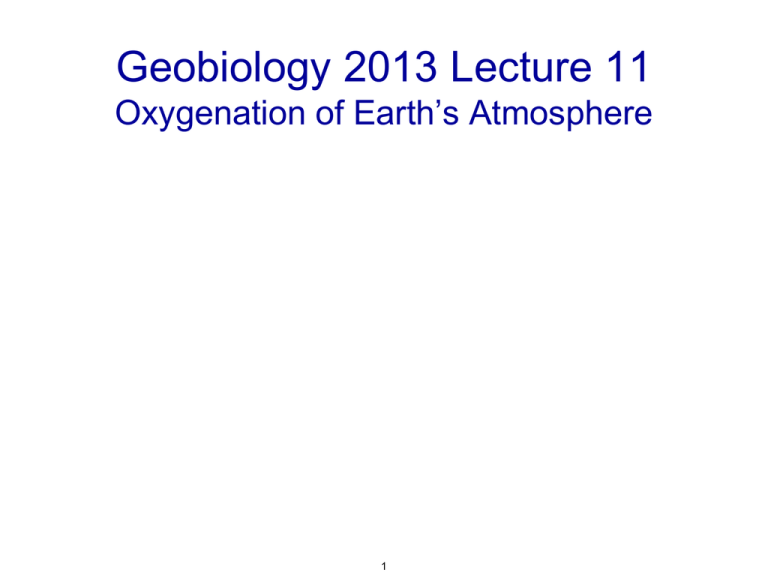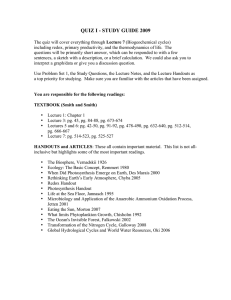
Geobiology 2013 Lecture 11
Oxygenation of Earth’s Atmosphere
1
Need to know
• How C and S- isotopic data in rocks are
informative about the advent and antiquity of
biogeochemical cycles
• Geologic indicators of changes in atmospheric
pO2
• A general overview of the course of
oxygenation of the atm-ocean system
• Reading: Anbar & Knoll, 2002. Science 297, 1137.
2
Biogeochemical Redox Couples
CO2 + H2O CH2 O + O2
oxygenic photosynthesis
Interdependency?
CH2 O + O2 CO2 + H2O
aerobic respiration
CO2 + 2H2 CH4 + 2H2O
methanogenesis
CH4 + 2O2 CO2 + 2H2O
oxidative methanotrophy
CO2 + HS- + H2O biomass + SO423
anoxygenic photosynthesis
Biogeochemical Redox Couples
aerobic respiration
CH2 O + O2 CO2 + H2O
1 mole glucose
O2
32 mole ATP
fermentation
1 mole glucose
2-4 mole ATP
Biosynthesis requires approx. 1mole ATP per 4g of cell carbon
4
Biogeochemical Redox Couples
oxygenic photosynthesis
CO2 + H2O CH2 O + O2
5
Biogeochemical Redox Couples
oxygenic photosynthesis
CO2 + H2O CH2 O + O2
6
Biogeochemical Redox Couples
anoxygenic photosynthesis
11H2O + CO2 + 4Fe2+ CH2O+ 8H++4Fe(OH)3
7
8
9
10
11
12
13
Precambrian Banded Iron Formations (BIFs)
Abundance of BIF Relative
to Hamersly Group as Max.
(Adapted from Klein & Beukes, 1992)
Canadian Greenstone Belts & Hamersley, W. Australia
Yilgaran Block, W. Australia
Transvaal, S. Africa
Paleoproterozoic (Huronian) Snowball Earth
Lake Superior, USA
Neoproterozoic
Krivoy Rog, Russia
Snowball Earths
Labrador, Canada
Rapitan, Canada
Urucum, Brazil
Damara, Namibia
Pongola Glaciation, Swaziland
(snowball??)
Zimbabwe, Ukraine,
Venezuela, W. Australia
Isua, West
Greenland
4.0
3.5
3.0
2.5
2.0
1.5
1.0
0.5
0
Time Before Present (Billion Years)
Courtesy Joe Kirschvink, CalTech
Courtesy of Joe Kirschvink. Used with permission.
14
Image by MIT OpenCourseWare.
Fe2+
Fe2+ + CO2 CH2O + 4FeOOH
Photic zone
Fe2+
(Canfield et al. 2006, Kharecha et al. 2005, Kappler et al. 2005)
15
Image by MIT OpenCourseWare.
H2O + CO2 CH2O + O2
16
Photic zone
STROMATOLITE RECORD OF MICROBIAL INTERACTIONS WITH
SEDIMENTS
This image has been removed due to copyright restrictions. Please see Figure 1 on page
http://www.annualreviews.org/doi/full/10.1146/annurev-earth-042711-105327.
Bosak et al., 2013
17
18
19
‘Classic’ picture of stromatolites, Telegraph Station,
Hamelin Pool WA. These are effectively stranded
above high water and ‘dead’.
Small (0.5) club-shaped subtidal stromatolites, Telegraph
Station
1m domal subtidal stromatolites, Carbla Point, Hamelin Pool
‘Reef’ of 1m stromatolites, Carbla Point
20
STROMATOLITES AS INDICATORS OF MICROBIAL PROCESSES
3.4 Ga
?
=
Allwood et al. 2007
modern
1.2 Ga
?
=
Photo: P. Hoffman
Jones et al. 1998
© Abigail Allwood, Paul Hoffman, et al. All rights reserved. This content is excluded from our
Creative Commons license. For more information, see http://ocw.mit.edu/help/faq-fair-use/.
21
1 mm
modern
ancient
(2.7Ga)
Jones et al. 1998
1cm
regularly occurring inter-column laminae
Flannery et al., 2012
© copyright owners. All rights reserved. This content is excluded from our Creative
Commons license. For more information, see http://ocw.mit.edu/help/faq-fair-use/.
22
STROMATOLITE MORPHOLOGY AND OXYGENIC PHOTOSYNTHESIS
AT 2.7 GA?
This image has been removed due to copyright restrictions. Please see
Figure 9 in paper online at http://www.mdpi.com/2076-3263/2/4/235.
Sim et al. 2012
23
STROMATOLITE MORPHOLOGY AND OXYGENIC PHOTOSYNTHESIS
AT 2.7 GA?
© mdpi.com. All rights reserved. This content is excluded from our Creative Commons
license. For more information, see http://ocw.mit.edu/help/faq-fair-use/.
Sim et al. 2012
24
STROMATOLITE MORPHOLOGY AND OXYGENIC PHOTOSYNTHESIS
AT 2.7 GA?
This image has been removed due to copyright restrictions. Please see Figure 6 on page
http://www.annualreviews.org/doi/full/10.1146/annurev-earth-042711-105327.
Bosak et al. 2013
25
4500
4000
500 million years
2500
O2
Image by MIT OpenCourseWare.
This image has been removed due to copyright
restrictions. Please see the image on page
http://en.academic.ru/dic.nsf/enwiki/365148.
26
MINERALIZATION THROUGH GEOLOGIC TIME
AGE ( Ga) 4
3
Banded Iron Formations
Conglomeratic Au and U
Bedded Cu in clastic strata
‘Red-Bed Cu’
Shale hosted Pb-Zn sulfides
Phosphorites
( a d a p te d fro m La m b e rt & G ro v e s , 1 9 8 1 )
27
2
1
0
An Atypical Banded Iron Stone (BIF)
28
Abundance of BIF Relative
to Hamersly Group as Max.
Precambrian Banded Iron Formations
(BIFs) (Adapted from Klein & Beukes, 1992)
Canadian Greenstone Belts & Hamersley, W. Australia
Yilgaran Block, W. Australia
Transvaal, S. Africa
Paleoproterozoic (Huronian) Snowball Earth
Lake Superior, USA
Neoproterozoic
Krivoy Rog, Russia
Snowball Earths
Labrador, Canada
Rapitan, Canada
Urucum, Brazil
Damara, Namibia
Pongola Glaciation, Swaziland
(snowball??)
Zimbabwe, Ukraine,
Venezuela, W. Australia
Isua, West
Greenland
4.0
3.5
3.0
2.5
1.5
2.0
1.0
0.5
0
Time Before Present (Billion Years)
Courtesy Joe Kirschvink, CalTech
Courtesy of Joe Kirschvink. Used with permission.
29
Pyrite (FeS2) is Unstable in O2-Rich
Environments
30
Multiple sulfur isotopes
33S
34S
36S
32S
δ36S
δ34S
δ33S
Mass-dependent Fractionation:
δ33S=0.515δ34S, δ36S=1.91δ34S
31
A quantitative O2 barometer??
Sulfur Isotopic Evidence for pO2 > 10-5 PAL
Oxidized
Atmosphere
Reducing
Atmosphere
(Mass-dependent processes, e.g.,
thermodynamic, kinetic, & biological
processes)
(Mass-independent processes)
∆33S=δ33Smeas-δ33Sexp= δ33Smeas -0.518*δ34Smeas
-data from sulfide & sulfate minerals
J. Farquhar, H. Bao, M. Thiemens (2000) Science 289:756-758.
© Science. All rights reserved. This content is excluded from our Creative Commons license.
For more information, see http://ocw.mit.edu/help/faq-fair-use/.
32
Conundrum: If oxygen-producing
photosynthesis was occurring by 3.52.7 Ga, why doesn’t free O2 appear
until 2.3 Ga, a 1200-400 Myr delay?
The BIG question in geobiology today!!
33
Conundrum: If oxygen-producing photosynthesis
was occurring by 3.5-2.7 Ga, why doesn’t free O2
appear until 2.3 Ga, a 1200-400 Myr delay?
Sources
•Photosynthesis
•Hydrogen escape
Vs.
Sinks
•Respiration
•Reduced minerals in rocks
•Reduced volcanic gases
•Reduced hydrothermal vent fluids
34
Life’s History on Earth
Cloud, Holland, Walker Paradigm
Prokaryote
World
Multi-cell
Life
1
0.1
Humans
First
Fossils of modern
eukaryotes (algae)
First
Invertebrates
GOE
2
PO (atm)
0.01
0.001
0.0001
Oldest robust fossil
and C-isotopic
evidence for life
0.00001
4.5
4
3.5
3
2.5
2
1.5
Time before Present (Ga)
1
0.5
© sources unknown. All rights reserved. This content is excluded from our Creative
Commons license. For more information, see http://ocw.mit.edu/help/faq-fair-use/.
35
0
Anbar & Knoll: Fig. 1. Biological and
geochemical changes during the Proterozoic
Eon.
This image has been removed due to copyright restrictions. Please
see Figure 1 in Paper online at http://www.sciencemag.org/content
/297/5584/1137.full.
Color gradations denote postulated changes in
deep sea redox. (A) Periods of deposition of
banded iron formations. (B) Range of values of
34S, the difference in 34S between coeval marine
sulfides and sulfates. Dashed line: 34S 20‰, the
maximum Archean value. Dotted line: 34S 45‰,
the maximum fractionation associated with singlestep BSR. Asterisk: 34S determined from a single
sample, and thus not well constrained. (C) Range
of values of 13Ccarb (after a compilation by A.
J. Kaufman). The frequency and magnitude of
variations in the Paleoproterozoic are somewhat
uncertain. (D) Eukaryotic evolution, as indicated
by the first appearances of body fossils (solid lines)
and molecular biomarkers (dotted lines), including
chlorophytes (1), ciliates (2), dinoflagellates (3),
rhodophytes (4), eukaryotes of unknown affinities,
possibly stem groups (5), stramenopiles (6), and
testate amoebae (7). See text for geochemical
references. Fossil distributions from (147).
36
This image has been removed due to copyright restrictions. Please see Figure 2 in
paper online at http://www.sciencemag.org/content/297/5584/1137.full.
37
This image has been removed due to copyright restrictions. Please see Figure 2 in
paper online at http://www.sciencemag.org/content/297/5584/1137.full.
Fig. 2. Schematic depiction of effects of changing ocean redox conditions on the depth
distributions of Mo (dashed lines) and Fe (solid lines). Influences of nutrient-type depletion and
aeolian inputs on surface seawater concentrations are omitted for simplicity. Color gradations are
the same as in Fig. 1. During the Archean, oceans are anoxic but not sulfidic. Significant O2 is only
associated with cyanobacterial “blooms.” Mo is scarce because it is not readily mobilized from
crustal rocks during weathering under low PO2. Fe is abundant in the absence of O2 and H2S.
From 1850 to 1250 Ma, moderate PO2 oxygenates surface waters but sulfidic deep waters
develop. Mo is scarce because of rapid removal in sulfidic waters. Mo is somewhat elevated at the
surface because of upper ocean oxygenation and enhanced oxidative weathering. Fe, as in the
modern Black Sea, is depleted in sulfidic deep waters, severely depleted in oxic surface waters,
and enriched near the redoxcline where both O2 and H2S are scarce. During the Phanerozoic, O2
penetrates to the sediment-water interface. Mo and Fe distributions are similar to today’s. See
text for details and references.
38
Evidence for O2 pulses during
the Phanerozoic
Pulse of atmospheric oxygen during the late
Cambrian
Matthew R. Saltzman, Seth A. Young, Lee R.
Kump, Benjamin C. Gilld, Timothy W. Lyons,
and Bruce Runnegar
PNAS 108,
39
3876–3881
Abstract
A rise in atmospheric O2 has been linked to the Cambrian explosion of life. For the
plankton and animal radiation that began some 40 million yr later and continued
through much of the Ordovician (Great Ordovician Biodiversification Event), the
search for an environmental trigger(s) has remained elusive. Here we present a
carbon and sulfur isotope mass balance model for the latest Cambrian time
interval spanning the globally recognized Steptoean Positive Carbon Isotope
Excursion (SPICE) that indicates a major increase in atmospheric O2. We
estimate that this organic carbon and pyrite burial event added approximately 19
× 1018 moles of O2 to the atmosphere (i.e., equal to change from an initial
starting point for O2 between 10–18% to a peak of 20–28% O2) beginning at
approximately 500 million years. We further report on new paired carbon isotope
results from carbonate and organic matter through the SPICE in North America,
Australia, and China that reveal an approximately 2‰ increase in biological
fractionation, also consistent with a major increase in atmospheric O2. The SPICE
is followed by an increase in plankton diversity that may relate to changes in
macro- and micronutrient abundances in increasingly oxic marine environments,
representing a critical initial step in the trophic chain. Ecologically diverse plankton
groups could provide new food sources for an animal biota expanding into
progressively more ventilated marine habitats during the Ordovician, ultimately
establishing complex ecosystems that are a hallmark of the Great Ordovician
Biodiversification Event.
40
Plot of (14) and (17) data from Mt. Whelan core in Australia that were used in the isotope
mass balance model (see Table S1) to calculate changes in atmospheric O2.
This image has been removed due to copyright restrictions. Please see the figure in the paper:
Saltzman, Matthew R., Seth A. Young, et al. "Pulse of Atmospheric Oxygen During the Late
Cambrian." 3URFHHGLQJVRIWKH1DWLRQDO$FDGHP\RI6FLHQFHV 108, no. 10 (2011): 3876-81.
Saltzman M R et al. PNAS 2011;108:3876-3881
©2011 by National Academy of Sciences
41
A Whiff of Oxygen Before the Great Oxidation Event?
Arial D. Anbar, Yun Duan, et al.
High-resolution chemostratigraphy reveals an episode of enrichment of the redox-sensitive
transition metals molybdenum and rhenium in the late Archean Mount McRae Shale in Western Australia. Correlations with organic carbon indicate that these metals were derived from
contemporaneous seawater. Rhenium/osmium geochronology demonstrates that the enrichment is a primary sedimentary feature dating to 2501 +
- 8 million years ago (Ma). Molybdenum
and rhenium were probably supplied to Archean oceans by oxidative weathering of crustal
sulfide minerals. These findings point to the presence of small amounts of O2 in the environment more than 50 million years before the start of the Great Oxidation Events.
http://www.sciencemag.org/content/317/5846/1903.full
Image by MIT OpenCourseWare.
42
Geochemical data from Mt McRae Shale ABDP-9
This image has been removed due to copyright restrictions. Please see the Figure 1 in the paper:
Anbar, Ariel D., Yun Duan, et al. "A Whiff of Oxygen Before the Great Oxidation Event?." 6FLHQFH
317, no. 5846 (2007): 1903-6.
43
MIT OpenCourseWare
http://ocw.mit.edu
12.007 Geobiology
Spring 2013
For information about citing these materials or our Terms of Use, visit: http://ocw.mit.edu/terms.


